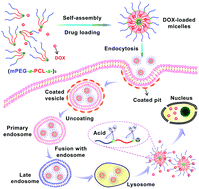Peihong Ni*a(倪沛红)
a College of Chemistry, Chemical Engineering and Materials Science, Suzhou Key Laboratory of Macromolecular Design and Precision Synthesis, Jiangsu Key Laboratory of Advanced Functional Polymer Design and Application, Soochow University, Suzhou 215123, P. R. China
Polym. Chem. 2015, 6, 1553-1566
A series of well-defined three-armed star-block copolymers containing poly(ethylene glycol) monomethyl ether (mPEG) and poly(ε-caprolactone) (PCL) blocks linked with acid-cleavable acetal groups, designated as (mPEG-acetal-PCL-acetal-)3 or (mPEG-a-PCL-a-)3, have been prepared via a "coupling-onto" method based on ring-opening polymerization (ROP) and Cu(I)-catalyzed azide–alkyne cycloaddition (CuAAC) "Click" chemistry. The chemical compositions and structures, as well as the molecular weights and molecular weight distributions (PDIs) of these copolymers have been fully characterized by 1H NMR, FT-IR, and GPC measurements. Differential scanning calorimetry (DSC) and wide-angle X-ray diffraction (WAXD) analyses demonstrated that the thermal behaviors of the star-block copolymers strongly depended on the relative lengths of PEG and PCL blocks in the arms. The self-assembly behaviors of these amphiphilic star-block copolymers were investigated by a fluorescence probe method, dynamic light scattering (DLS) and transmission electron microscopy (TEM) analyses. The results showed that they could self-assemble into spherical micelles at low concentrations and mainly formed short rod-like micelles at high concentrations. Moreover, the acid-cleavable properties of these star-block copolymers were systematically studied by 1H NMR, GPC, and DLS measurements, and the results indicated that they were relatively stable in neutral pH media, but could be degraded under acidic conditions. The in vitro DOX release studies showed that DOX was released from drug-loaded micelles in a pH-sensitive manner. MTT assays demonstrated that these star-block copolymers possess low cytotoxicity against L929 cells and HeLa cells, and the DOX-loaded micelles exhibit a higher inhibition of the proliferation of HeLa cells in comparison with free DOX. Moreover, the results from the live cell imaging system and flow cytometry analysis revealed that these polymeric micelles could efficiently deliver and release DOX into the nuclei of HeLa cells. These pH-triggered shell-sheddable micelles are highly promising for the efficient intracellular delivery of hydrophobic anti-cancer drugs.

链接:
//pubs.rsc.org/en/content/articlelanding/2015/py/c4py01391c#!divAbstract